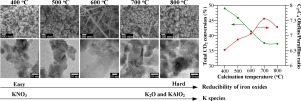Applied Catalysis A: General ( IF 4.7 ) Pub Date : 2017-09-08 , DOI: 10.1016/j.apcata.2017.09.006 Thanapa Numpilai , Thongthai Witoon , Narong Chanlek , Wanwisa Limphirat , Giuseppe Bonura , Metta Chareonpanich , Jumras Limtrakul

|
Fe-Co/K-Al2O3 catalyst has been reported to be active and selective for olefin production from CO2 hydrogenation. However, the effect of calcination temperature on the physicochemical properties of Fe-Co/K-Al2O3 catalysts as well as their catalytic activity in CO2 hydrogenation to olefins has not yet been addressed. Here, we show that the calcination temperature (400–800 °C) has significant impacts on metal oxides crystallite size, on the interaction between Fe2O3 and other metal oxides and on the transformation of potassium phases, which affect CO2 conversion, product selectivity as well as yield of olefins. The Fe-Co/K-Al2O3 catalyst calcined at 400 °C achieves the highest CO2 conversion, hydrocarbons selectivity and olefins yield of 49.0%, 90.6% and 18.1%, respectively. The CO2 conversion and hydrocarbons selectivity decrease with ascending calcination temperature which is ascribed to the increase of metal oxides crystallite size, inducing stronger interactions between Fe2O3 and other metal oxides. Unlike the CO2 conversion and hydrocarbons selectivity, the olefins to paraffins (O/P) ratio followed a volcano-shaped trend as the function of calcination temperature with a maximum at 7.6 over the Fe-Co/K-Al2O3 catalyst calcined at 700 °C. This volcanic trend is attributed to the interplay among the positive effect of high calcination temperature on the complete decomposition of KNO3 to K2O, a stronger interaction between Fe2O3 and K2O and the formation of KAlO2 phase, favorably suppressing the hydrogenation of olefins, and the negative effect of high calcination temperature on the increase of the particle size of the active phase and lower dispersion of mixed metal oxides due to a drastic decrease in BET surface area.
中文翻译:

Fe-Co / K-Al 2 O 3催化剂在不同温度下煅烧以将CO 2加氢为轻质烯烃的结构-活性关系
据报道,Fe-Co / K-Al 2 O 3催化剂具有活性,对从CO 2加氢生产烯烃具有选择性。然而,尚未解决煅烧温度对Fe-Co / K-Al 2 O 3催化剂的物理化学性质以及它们在CO 2加氢成烯烃中的催化活性的影响。在这里,我们表明煅烧温度(400–800°C)对金属氧化物的晶粒尺寸,Fe 2 O 3与其他金属氧化物之间的相互作用以及影响CO 2的钾相转变具有显着影响。转化率,产物选择性以及烯烃的收率。在400°C下煅烧的Fe-Co / K-Al 2 O 3催化剂实现了最高的CO 2转化率,烃选择性和烯烃收率,分别为49.0%,90.6%和18.1%。随着煅烧温度的升高,CO 2的转化率和碳氢化合物的选择性降低,这归因于金属氧化物微晶尺寸的增加,从而引起了Fe 2 O 3与其他金属氧化物之间更强的相互作用。与CO 2不同转化率和碳氢化合物的选择性,烯烃与链烷烃(O / P)的比值呈火山状趋势,是煅烧温度的函数,相对于在700°C下煅烧的Fe-Co / K-Al 2 O 3催化剂,最大值为7.6 。这种火山的趋势归因于高煅烧温度对KNO 3完全分解为K 2 O的积极作用,Fe 2 O 3和K 2 O之间更强的相互作用以及KAlO 2的形成之间的相互作用。 相,有利地抑制了烯烃的氢化作用,并且由于BET表面积的急剧降低,煅烧温度高对活性相的粒径增加和混合金属氧化物的分散性降低的负面影响。











































 京公网安备 11010802027423号
京公网安备 11010802027423号